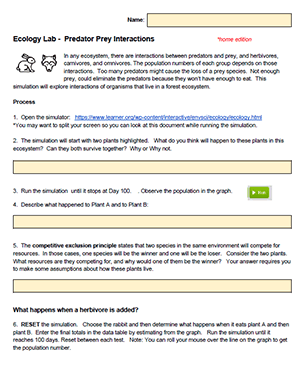
This activity was designed for students during the 2020 Covid19 Pandemic. It utilizes an interactive program that allows students to manipulate the type of organisms within a system and what they eat. The simulation found at learner.org and is free to use.
For example, the sim starts with two types of plants. If you run the sim with only those two plants, one of them will go extinct. Students explore these types of relationships while learning about the competitive exclusion principle, predator-prey cycles, and the difference between a specialist and a generalist.
Students establish an ecosystem where all of the elements are in “balance” and no individual species dies off. This balance usually can be achieved by including predators (like a wolf) to keep herbivore populations from overgrazing the plants. The concept of a keystone species is introduced at the end.

This activity may be challenging for some freshman level classes. The concepts are something that ideally, I would work through slowly with class discussions and guiding questions to clear up any confusion. I also suspect some students will have trouble operating the controls of the program. Again, if students were in class, you could display the program on the projector and show them how to use the controls and read the graphs.

HS-LS2-2 Use mathematical representations to support and revise explanations based on evidence about factors affecting biodiversity and populations in ecosystems of different scales.
HS-LS2-6 Evaluate the claims, evidence, and reasoning that the complex interactions in ecosystems maintain relatively consistent numbers and types of organisms in stable conditions, but changing conditions may result in a new ecosystem

